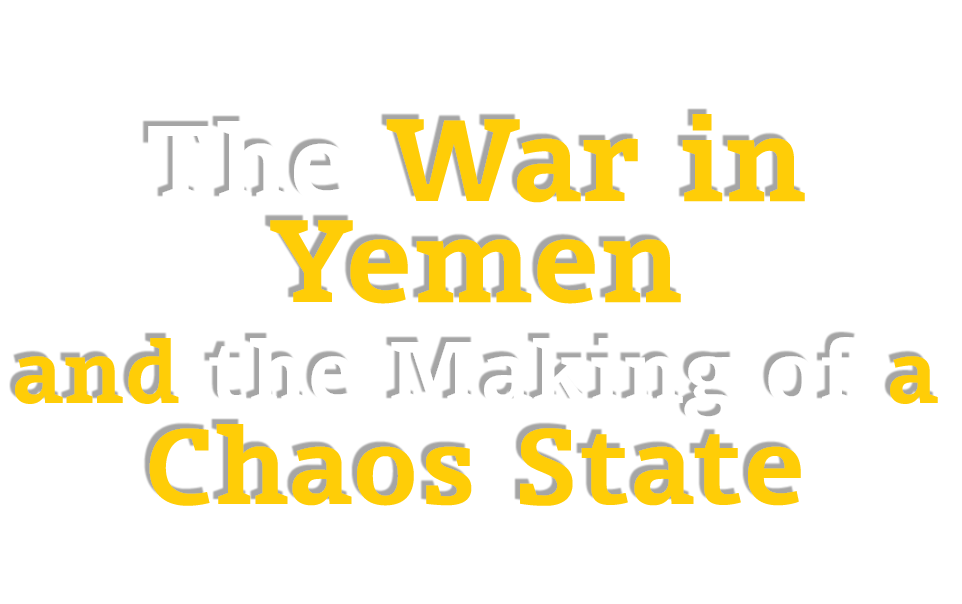
.jpg)

By Ben Watson
More than 1,000 days of fighting have turned Yemen into one of the most dangerous places on the planet. We talked to aid workers, journalists, and experts, who described little-appreciated realities about the war and — just maybe — ways to turn things around.

Introduction
A strange and worrisome silence settled over Yemen’s capital city of Sana’a after Houthi rebels seized power in broad daylight one September day in 2014. For weeks, rumors had been floating that something of this sort would occur. But most everyone thought a genuine coup d'état would be much more dramatic.
“I was actually wandering around the city and there was this eerie quiet,” said Iona Craig, an independent journalist who was living in Sana’a the day the rebels officially seized power, taking government buildings, even the military headquarters. “I remember I was very close to the Ministry of Defence and somebody called me and said, ‘The Houthis have taken the Ministry of Defence.’ And I said, ‘Don’t be ridiculous, because there’s not a single shot being fired. I’m standing 150 meters away from it.’”
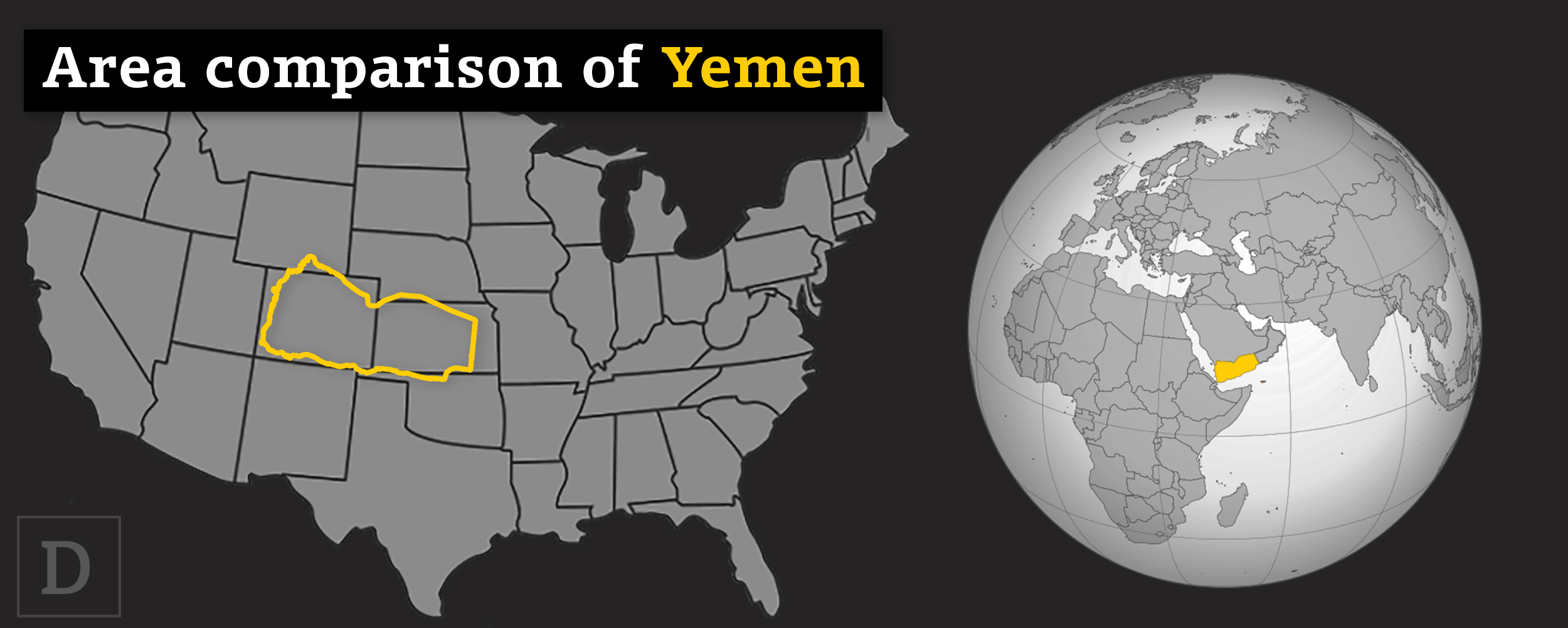
And so hardly anyone noticed much of this outside of Yemen. That wasn’t unusual for the Arab region’s poorest country, which rests quietly across from Somalia on the Mandeb Strait, astride the world’s fourth-busiest petroleum-shipping choke point.
Once it had become clear that Houthis had seized Sana’a, and were resolutely marching south to the port city of Aden, the fate of a struggling nation’s 26 million people — 8 million of whom were already facing famine conditions — began a dark turn for the worse. Basic government functions, already shoddy, ceased almost entirely. In the eastern seaport of Mukalla, al-Qaeda in the Arabian Peninsula briefly ran their own de facto state, largely because they were willing to clean the trash off the streets.
Two-thirds of Yemenis were already what the UN called “food insecure” before the Houthis advanced south, but in the nearly three years since then, Yemen and the wider Middle East have plunged into a dangerously unstable condition. Never known as an international tourist draw, the country has recently been making headlines for outbreaks of cholera and diphtheria — and ballistic missiles that travel hundreds of miles toward to the Saudi capital of Riyadh. With the war on ISIS slowing down in Syria and Iraq, Yemen is now the world’s worst humanitarian crisis.
The thousand-day war in Yemen has embroiled nearly a dozen nations, most allied closely with Saudi Arabia. That means most of them are, by extension, allied against Iran, which stands accused of arming the Houthis. Of particular concern, the commander of U.S. Central Command told reporters Monday, is that Iran is arming the Yemeni rebels with ballistic missiles. Gen. Joseph Votel said this created a "growing missile threat that is being orchestrated by Iran through the Houthis, and which I think poses a significant danger, not just to Saudis and Emiratis, but in cases where we have our forces and citizens co-located it poses a risk to us.”
A few of those Saudi allies are wondering how to proceed, now that the Saudi-led war on the Houthis has largely stalemated in a horseshoe around Yemen’s western highlands. And even though the Saudis have succeeded in some respects along the southern coast, the broader fighting has accelerated the country’s descent from failed state into a “chaos state.”
“Yemen more closely resembles a region of mini-states at varying degrees of war with one another, and beset by a complex range of internal politics and conflicts, than a single state engaged in a binary conflict,” wrote Peter Salisbury, a researcher with the London-based Chatham House policy institute, in a December report on the country.
Yemen has been a hotbed for extremism since the Afghan civil war ended in the 1990s. For more than 15 years, the U.S. military has used drones (primarily) to kill Yemen-based descendants of those foreign fighters, now known as al-Qaeda in the Arabian Peninsula. This sustained war-within-a-war may be one of the few relative bright spots inside Yemen today, with some experts saying the U.S. military may be enjoying its most successful period against AQAP to date. For a brief time, even Yemenis changed their minds about American drone strikes in their country, thanks to improved targeting methods that have reduced civilian deaths and collateral damage.
But Yemeni attitudes began to swing back in 2017, beginning with the bloody Jan. 29 U.S. special forces raid in central Yemen. The rest of the year brought little change to the front lines of the Saudi-led war.
The persistence of the Houthi rebellion — and the fact that more than 8,000 civilians are believed to have been killed since March 2015 — has turned up the pressure on Washington. The rarely-asked question looming above it all: What does the U.S. expect the Saudis to be able to achieve in Yemen? December was a particularly bloody month for Yemeni civilians, with more than 100 killed in Saudi airstrikes in a single 10-day period. The war’s rising civilian toll has prompted tense responses from U.S. Defense Secretary Jim Mattis. In late December, he told a Reuters reporter he’s “never okay with civilian casualties” and not to “screw with me on this.”
“The costs of war throughout history — and it has not changed — are more heavily borne by civilians, as far as I'm concerned, in almost every war in history,” said Mattis.
“I leave perfection to God,” the defense secretary said of the U.S. military’s mission in Yemen. “We're going to do our best to reduce the numbers and try to get this thing to the U.N.-brokered negotiating table, if that puts it in a broader context.”
A review of Yemen’s recent history, however, suggests there are still many months of fighting, and many more civilian deaths, before that may happen.
Old lines and fallen empires
In the mid-1990s, the CIA tried to analyze how nations and states fall apart. The study didn’t advance that far because there really wasn’t enough data at the time. Too few states had fallen by 1994 to really get a good read on how they fail. But a look at Yemen today suggests more than a few answers to that question — and a whole host of problems that go along with it, which are likely to plague the region for many generations.
The tinderbox that is Yemen today can in some ways be seen as the enduring failure of three fallen 20th-century empires. It was Britain who initially put Yemen on the West’s maps. The southern port city of Aden became a key supply point for British warships traveling to and from India, especially after the Suez Canal opened in 1869. The Brits, along with the Ottomans, also introduced the idea of partition to the area, drawing a north-south border line that still largely exists today.
“Some of what you see today mirrors events that have kind of occurred in Yemen throughout its history,” said John Arterbury, a Middle East analyst focusing on Yemen at the Navanti Group in Arlington, Va. “The concept of Yemen is not new, certainly… But seldom has it ever been any sort of unified or uniform entity. So, what you’re seeing now kind of with the Houthi rebellion — although they are occupying Sana’a, which is fairly new in terms of how these dynamics kind of play out — it is a bit of a repeat between what is historically been a North-South divide in Yemen.”
Like the Ottomans during their time in Yemen, and Egypt’s incursion in the mid-1960s, the British presence in the South sparked years of violent resistance. (The final UK troops departed Aden in 1967.) The Egyptians fought an insurgency in Yemen in the 1960s, but in the North. (Unlike Nasser and the Egyptians, the British didn’t use mustard gas.) Decades of occasional missile sales from the Soviets to both the North and the South preceded Yemen’s unification in 1990. “Yemen is sort of legendary in the missile world because when the civil war was going on [in the 1990s], both sides had gotten their hands on Russian ballistic missiles and were firing them at each other,” said Aaron Stein, a resident senior fellow at the Atlantic Council's Rafik Hariri Center for the Middle East. “One had a Tochka, the other one had the Scud-B.”
The remnants of these missile arsenals are believed to be in Houthi hands, and launched against their enemies since taking Sana’a in 2014. The proliferation of these weapons, along with a torrent of small arms and rocket parts believed to have come from Iran, has propelled the Houthis well beyond a Yemeni rebellion and into a full-blown regional threat to security. And that doesn’t even take into account the other war going on inside Yemen: America’s war on al-Qaeda.
Al-Qaeda takes root
A culture of impunity, if little else, ruled over Yemen and the surrounding area in the years after unification. “Yemen has always historically been a destination for smuggling and migration in the greater Horn of Africa,” Arterbury said. “You still have migrants coming into the the province of Shabwa, kind of in southern central Yemen. And they will transit actually directly from Somalia, and kind of circumvent that maritime interdiction ring that’s a little more intense on the western coast of Yemen.”
The country’s civil war in 1994, however, opened the door for a handful of migrants from the opposite direction: “a relatively small number of jihadists, many of them returnees from Afghanistan, were utilized by the regime of Ali Abdullah Saleh against the socialist south,” Salisbury wrote in his Chatham House report. (These men returned to Yemen just one year after the U.S. military’s disastrous episode in neighboring Somalia when 19 Americans were killed and two UH-60 Black Hawks were shot down in the Battle of Mogadishu.) Saleh’s 1994 civil war “was won by the regime, but the jihadists empowered during the conflict became the forerunners of AQAP,” he wrote.
“Al-Qaeda in the end became a financial benefit really for the state,” said Iona Craig, a freelance journalist who has lived and worked in Yemen for years. “There has been a long history of political assassinations in the country going way back, even preceding Ali Abdullah Saleh’s time in politics. And al-Qaeda almost became a continuation of that — particularly for the now-late Ali Abdullah Saleh when it became quite clear that there was a threat of al-Qaeda that there would be more money put his way in the form of counterterrorism funding, military training, military equipment.”
It’s hard to overstate how badly Saleh robbed Yemen. Some estimates say he personally stole $60 billion during his 33-year rule, much of it U.S. cash meant to help fight al-Qaeda.
Alliances with al-Qaeda and other shady actors are everyday business inside Yemen, but the war has only complicated things, said Elisabeth Kendall, senior research fellow in Arabic and Islamic Studies at Oxford University’s Pembroke College. She’s made multiple trips to Yemen over the years, most recently in August.
“Al-Qaeda now don’t hold territory, but they have made strong alliances with tribes,” she said, particularly in the al-Bayda highlands north of Aden, near Houthi forces. “They’re fighting the same mutual enemy — the Houthis — and they’re feeling embattled on various fronts in the home territories against the Houthis. Why would you not hook up with a bunch of guys with guns just because they’re waving black flags?”
It’s a point U.S. policymakers would be wise to understand for their counterterrorism efforts, Kendall said. Her travels have included countless discussions with tribal leaders throughout southern and central Yemen — the location of many of America’s drone strikes against AQAP.
“If you've got a mutual enemy, you'll fight alongside them. And I sometimes think this is a nuance that the U.S. doesn’t quite capture, or doesn’t wish to capture, perhaps,” she said. “But it’s very important that that nuance, that that distinction between tribes and core al-Qaeda is captured, is understood. Because if it isn’t and you end up just killing people who are not really classed as al-Qaeda, just simply that they’re cooperating with them, then you really will get a strong backlash.”
This is a problem in Yemen, where Saudi jets are dropping U.S.-made precision weapons. But worse is that no one is talking about unifying Yemen, much less any second- or third-order effects of what an end to airstrikes might look like. The death of Saleh removed one of the key bonds of the country's non-Houthi coalition.
“For a lot of these groups, it’s still an alliance of convenience against the Houthis,” Arterbury said. “And that’s one interesting long-term factor that I think people should be concerned about — is what happens if and when the Houthis are eventually kind of driven out of Southern Yemen? You’re gonna be left with a weird mix of tribes and Islamists and southern secessionists. You know, how does that kind of shake out in the long term?”
Rise of the Houthis
Many of the factors that helped al-Qaeda endure in Yemen — widespread poverty, decades of government corruption, and another six years of civil war starting again in 2004 — also fostered Shi’a-aligned Houthi armed opposition in northern Sa’dah province. The group’s spark was fanned into a flame when Saleh’s forces killed its leader. According to Arterbury, the Houthis were a rebellion that had not historically been extreme. That is not so anymore.
“One thing you have witnessed,” he said, “and it is partly through attrition and it is partly through, at this point, making the conflict more of a binary, zero-sum game, you’ve witnessed kind of the ascent of the hardline wing within the Houthi movement.”
By the time the Arab Spring hit Yemen in 2012 — forcing Saleh from office and elevating his deputy, Abdrabbuh Mansur Hadi — the Houthis had fought or won over much of the north and central highlands. Saleh, who had ruled Yemen for more than three decades, appeared to take it in stride.
“Saleh at the time then sort of said he was retiring from politics and he was putting his feet up and tend his garden and write his memoirs,” Craig said. “And I don’t think anybody who’d ever watched Ali Abdullah Saleh over the preceding 33 years thought that was realistic. He was able to maintain his position as leader of his political party, the GPC [or General People's Congress]. And was also quite crucially given immunity from prosecution as well.”
Many of Saleh’s soldiers either passively permitted Houthis to rule the north, or actively collaborated, handing over weapons and supplies — eventually, even ballistic missiles. And when the Houthis swept into Sana’a in 2014, the ousted Saleh thought his fortunes had turned, and he re-entered Yemeni politics on the side of the rebels.
“Saleh’s loyalists who were around all of those key government institutions allowed the Houthis then to set themselves up and take country of all of the government administration,” said Craig, describing the day Sana’a fell. It may have even saved thousands of lives. “It was a very smartly-done exercise in the end by Saleh, and it meant [the Houthis] were able to take control without having to fight for the city at all in the end really.”
But the Houthis wanted more than the capital. Despite signing a truce in Sana’a that September, the Houthis began marching south, killing and taking territory under the banner of fighting al-Qaeda. Most concerned Yemenis were unsure of what to make of the Houthis' southern advance, thinking there might be another shot at stability with the Houthi-Saleh alliance. But in early 2015, the group launched its most ambitious drive when they stormed into Aden, seized the airport, and sent the sitting president fleeing for his life to neighboring Saudi Arabia.
Saudis and allies declare war
The Saudis and local allies — along with the U.S. and Britain — launched their war on the Houthis in Yemen on March 21, 2015. Dubbed Operation Decisive Storm, it began with a maritime blockade. Three navies sent more than a dozen ships to the Yemeni coast; in the weeks that followed, Saudi and Emirati special forces slowly advanced into and around Aden. When Saudi jets began their far-from-precision bombing campaign, the war turned unmistakably violent for Yemen’s starving millions. It was also immediately a boon for al-Qaeda, whose recruiters were in place and ready to capitalize.
Ambitious in scale and in scope, the operation brought 10 nations to ally with the Saudis against the Houthis; the U.S. contributed aerial surveillance and resupply missions. Nine air forces mustered almost 200 aircraft to strike Houthis across the entire western half of Yemen early in the operation. American airstrikes, meanwhile, targeted al-Qaeda positions largely to the east.
In April, just three weeks into the broad opening offensive, its name was changed to Operation Renewal of Hope. Here’s what Riyadh said, and still says, its war is meant to achieve:
- The protection of Yemen from a takeover by Houthi militias and their allies.
- The security of the Kingdom of Saudi Arabia and neighboring countries, especially from ballistic missiles and heavy weapons captured by the Houthi militias and their allies.
- The neutralization of most of the military capabilities of the Houthi militias and their allies that represented a threat to Yemen and neighboring countries.
- The prevention of the flow of weapons from outside of Yemen into the country.
- The protection of the legitimate government and its ability to conduct its affairs.
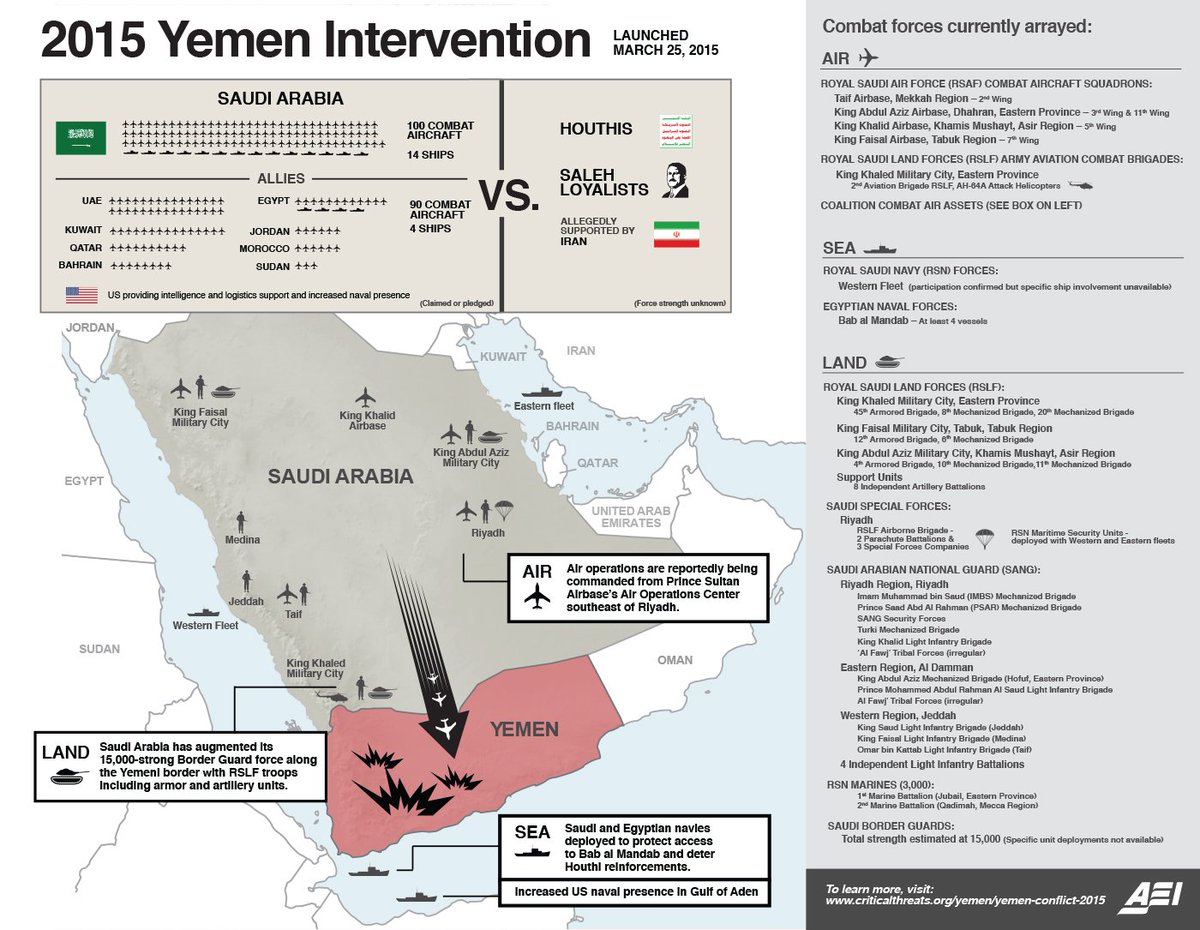
But to Yemenis, the war looks very different. “Yemen was never good. But the situation was never bad like this,” said Radhiyah Al-Mutawakkil, who leads Mwatana, an independent Yemeni human rights group. “If you tried, or anyone tried to know what is the project of the parties to the conflict in Yemen, what do they want, what they are planning to do, you will never know. Because there is no logic in all that’s happening on the ground now.”
What appears to have happened is an enormous amount of damage to Yemen’s already brittle infrastructure. “For example, the bridge that is the main supply route between the Red Sea port of Hodeida on the west coast to the capital, Sana’a,” Craig said. “That was quite clearly deliberately destroyed [in Saudi-led airstrikes] despite apparently being on a no-strike list of targets suggested by the U.S…. The Saudis have completely ignored this and hit those targets.”
Nearly a third of the Saudi-led coalition airstrikes have hit what local observers at the Yemen Data Project call “non-military” targets. “In that you would include, for example, marketplaces, water and electricity sites, food storage, hospitals, medical centers, mosques and all those kind of things,” Craig said. “Less than 45 percent of Yemen’s medical facilities are now operating because of the conflict. People can’t, a lot of the time, afford to get there.”
Since the war began in March 2015, Saudi aircraft have bombed water and electrical infrastructure more than 100 times. Beyond that, “There have been 68 air raids that have targeted medical facilities; 183 that have targeted marketplaces,” said Craig.
Coupled with neglected city streets and poor sanitation, Yemen’s cholera epidemic — one of the worst ever recorded, with roughly one million infected — has placed an unsustainable strain on not just the country, but nearly all of its crisis-response groups.
War has also driven up the costs of food. According to the UN, in a Decamber 2017 report, "Overall prices are still much higher than the pre-crisis prices by 137.2 percent for maize in Hadramout, by 94.0 percent for sorghum in Taiz, 100.8 percent for maize, 74 percent for millet and 207.7 percent for barley in Hodeidah." As well, "animal production, including poultry sector, is under huge stress" as the price of grain feed has gone up while "household purchasing power" remains low.
“Yemeni people, they didn’t used to debate on the state a lot because we never have a very good and strong state,” said Radhiyah, the human-rights organization leader. “But in Yemen, if the war didn’t stop, in a certain time, humanitarian NGOs will have to feed each Yemeni. And this is impossible.”
United Nations
And the outlook for Yemen’s children? “It’s grim,” said Craig. “I mean you’re at a conflict level in cities and town and even villages where I’ve been actually, where there’s been fighting, there’s kind of become this normalization of violence to a lot of them.
“I’ve been in Taiz, for example, where you’ve got children living in sniper alleys, which means that they can’t go out and play in the street because if they do they’re gonna be in the range of snipers. They’ve watched friends and family members being killed by those snipers. And it’s almost become normal to them. They’re not afraid. They’ll come to talk to you across the street. They’ll duck down and run across the street toward you. And then you’ll run back with them. And that’s somehow become normal life, which is absolutely terrifying.”
“And they’re not afraid now,” said Craig. “When they hear the shelling or they hear the gunfire, they don’t flinch even though many of them have seen people killed.”
"There are families in Yemen, very educated families, if you asked me four years ago if those families, their siblings their sons would participate in the war, I would never believe it," said Radhiyah. "And now many, many of these educate families, their sons are in the war fighting."
The Houthis may not have an air force, but their weapons might have more lasting effects. “Land mines, indiscriminatory detention and torture, enforced disappearance. Not only in Sana’a where they control the other governorates. But also in Taiz in the middle of the city,” Radhiyah said. The middle of cities like Taiz have also been where Houthis have sent large ballistic missiles. No air force, sure; but nearly as terrifying and just as deadly. Amd the Houthis have launched them into Saudi Arabia at greater distances each year of the Yemen war.
Rebels armed with ballistic missiles
In March 2015, the Saudi government publicly estimated that the Houthis held 60 or so ballistic missiles, most seized from army depots, others later alleged to have been transferred from Iran. (In January 2018, the leader of U.S. Central Command said Iran was definitely helping arm the Yemeni rebels. Gen. Joseph Votel talked with reporters about "this growing missile threat that is being orchestrated by Iran through the Houthis, and which I think poses a significant danger, not just to Saudis and Emiratis, but in cases where we have our forces and citizens co-located it poses a risk to us.")
Like Saudi tank losses, the Houthi missile problem may in fact be much bigger than Riyadh has publicly admitted. Riyadh and its allies have defended themselves against more than 87 long-range Houthi missile launches, “some 50 of which the Saudis have tried to keep secret,” Newsweek reported in November, citing unnamed Middle East intelligence sources.
At least five Houthi ballistic missiles are thought to have flown the roughly 900 kilometers from north Yemen to Riyadh — including one that landed near the international airport on Nov. 4, prompting an press conference from Nikki Haley, U.S. ambassador to the UN. The Saudis took some flak for this attack among observers since Riyadh initially said the missile had been intercepted. A sixth hit a Saudi Aramco oil refinery in Yanbu, almost as far as Riyadh on the Red Sea coast. Dozens have landed inside Yemen as well, but an accurate count is elusive.
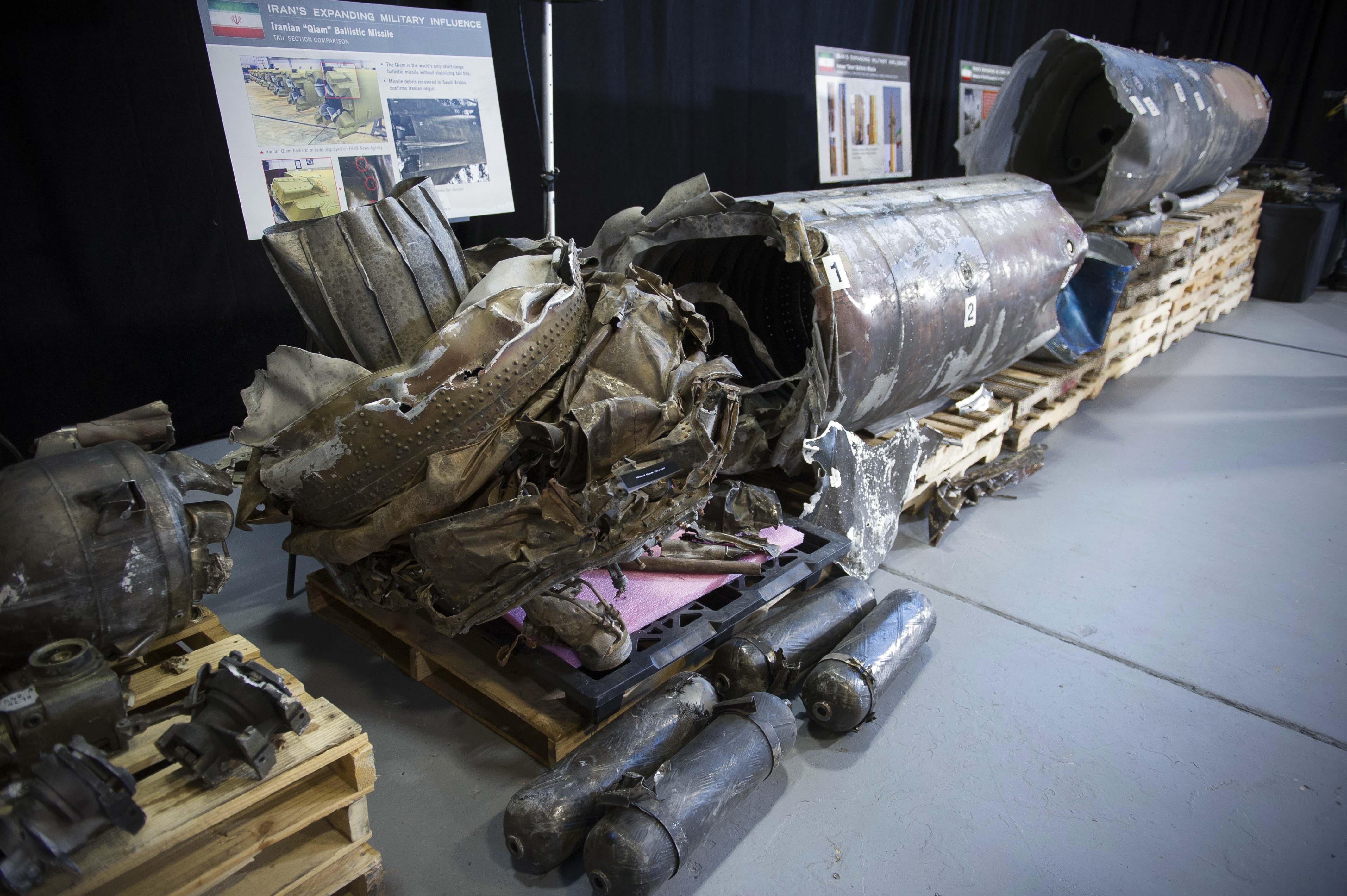
(AP Photo/Cliff Owen)
Here are a few things we do know about the Houthis' firepower.
“The Houthis kind of have three named missiles, or rocket families, that they refer to a lot," said Arterbury. "We witness the Burkan — that was the one you know they fired at Riyadh; they’ve actually fired several of those into Saudi [Arabia], but more famously it’s gotten a lot more attention; then the Qaher-class is a shorter-range one that they tend to fire across either the Saudi border, or they’ll fire at kind of hot front lines within Yemen. And finally, you have a third class called the Zelzal, which means 'earthquake' both in Farsi and Arabic, and those are actually — the Zelsal-1 and -2 are actually probably more like improvised rocket-assisted mortars like you witness some groups using in Syria. The Zelzal-3 is a bit more unclear; it might be closer to a short-range ballistic missile, but the Qaher is kind of their go-to medium-range.”
On the other side of this missile war is one of the its more puzzling facts, said Aaron Stein of the Atlantic Council. “The Saudis should be slightly better at finding these things,” he said, particularly of the Houthis' longer-range, Iranian-made Qiom rockets, “because there are similar launch points that we’ve seen. And there are Patriot units on the border; Patriot has 180-degree field of fire in the engagement zone. So because it has 180-ish degree field of fire, you need two for 360.
“But in this case you’re only oriented towards a border, you should be able to point it more or less at Sa’dah so your radars will pick it up earlier and you can get a good weapons track on it. Or at least try and shoot it down closer to the border,” he said. “You have to be asking yourself why the Saudis aren’t pointing their damn Patriots in the right position?”
Not that Scud hunting, as Stein puts it, is an easy task, broadly speaking. “In fairness to the Saudis, to be nice to them, road-mobile Scuds are very, very hard to hit. And the Qiom is, at its core, a road-mobile Scud. Even the best of the best — the U.S., the Israelis — have trouble Scud hunt[ing] because, you know, deserts are big, Scuds are small, and you have to patrol a lot of territory to find these things…But they keep firing from around the same area.”
The U.S. and the Saudis allege many of the Burkans are actually Iranian Qiom missiles (customized -B and -C Scuds) that have been disassembled, shipped over water, then driven in trucks to a storage point for re-assembly. Many routes taken, according to the Chatham House, have run through Oman and into Yemen’s more sparsely populated east. It’s a trade that Oxford’s Kendall says has been “extremely lucrative” for Yemen’s shady power brokers.
“The difference I’ve seen over the last two years in my various trips has been stunning,” she said, “from practically traffic jams going over the border from Oman into Yemen to now fresh fruit hanging in the streets, new shops, spanking new hotels opening at $250 a night, new roads being built — it’s incredible. Most ordinary people can’t get anywhere close to that. So it must just be money laundering and fueled by the smuggling industry.”
“There’s obviously no end-use certificates on any of these things,” said Stein of the weapons, like Iranian-made rockets, and how they make it to Houthi hands. “So we have no idea when these missiles were first put in. They could have been put in five years ago for all we know, 10 years ago.”
The bottom line here, said Arterbury, is “the Houthis have kind of a become a low-cost, medium-high reward way of Iran countering Saudi Arabia in the peninsula. And of course, the most dramatic way that you could witness this is through missile tech.”
“The missiles that they’re launching now, judging by the photos released by the [Defense Intelligence Agency] and the Pentagon, are not indigenous to Yemen’s stocks. So it has kind of morphed and metastasized with time,” Arterbury said. “And honestly for Saudi [Arabia], they always saw Iran from the very beginning and they probably overstated it, but now their kind of nightmare has become a reality.”
That reality has come in the form of Burkan-1 short-range ballistic missiles launched at southwestern Saudi cities — Jizan, Najran, Abha, and Al-Tuwai — and almost as many at Saudi coalition forces inside Yemen, mostly in Taiz.
While the Saudis have purchased Patriot PAC-3 anti-missile systems, they don’t appear to be using them. Rather, most of the Saudi intercepts are assumed to use Patriot PAC-2 systems, with a blast-fragmentation warhead like the interceptors the U.S. military deployed in the Gulf War in 1991.
Coalition navies have had their chance to fend off missiles and remote-controlled boat bomb attacks, too. Twice in October 2016, Houthis launched cruise missiles at the American destroyer USS Mason (DDG-87). The Navy responded by launching Tomahawk cruise missiles at the suspected coastal radar stations where the attacks were believed to have originated.
Al-Qaeda's quiet descent
Even before that skirmish in the Red Sea, the war in Yemen had created tens of thousands of refugees and sent millions of people fleeing to the coasts. Many even fled to the al-Qaeda-controlled east by 2016, given its perception as a “much safer, more stable place to be,” said Kendall, who witnessed the exodus during one of her trips that year. “One of the things that actually started to cause friction inside Mukalla when I was around in the area doing interviews, was that there was such an influx of people from the north who were trying to escape the war, coming and trying to join al-Qaeda because they felt that it gave them better options and more safety for their families.”
But wind the clock ahead to 2018, and al-Qaeda is in a very different place. No more de facto state in Mukalla. No more slick media operations. Many U.S. drone strikes — a three-fold increase during President Trump’s first year in office, for example. It’s been a quiet change, and its effectiveness appears to be the result of years of more precise targeting by U.S. drone operators.
“I’m not a fan of drone strikes, but it does seem to be doing the job,” Kendall said. “Maybe three years ago when I was traveling in Yemen, they were absolutely, lividly against drone strikes in the east. And then towards the end of the Obama administration, the drone strikes seemed to be slightly better targeted, they seemed to be actually targeting genuine Al-Qaeda core fighters, and in vehicles when they’re traveling between A and B. So they’re not harming infrastructure, they’re not killing villagers. And there was a bit less complaining, as far as I could tell.”
The success may have been short-lived, she said, because that all changed “when Trump came in and we had that disastrous raid in January. The whole anger started to boil up again.”
Still, said Arterbury, “it’s certainly not helping them when they’re consistently losing what are probably mid to lower senior level leaders every few weeks. So recently, for example, they eulogized a propagandist — a guy named Abu Hajer al-Makhi, a Saudi national who had been working for them for several years — and the suspicion is they’ve witnessed a lot of attrition in their media department, to the point where you know AQAP has not put out an Inspire magazine in ages, their media production on their Telegram channels has actually kind of fallen dramatically. Whether you can correlate this to the drone program, that might be you know reading a bit too much into it, it might not be; it’s just hard to say from the outside.”
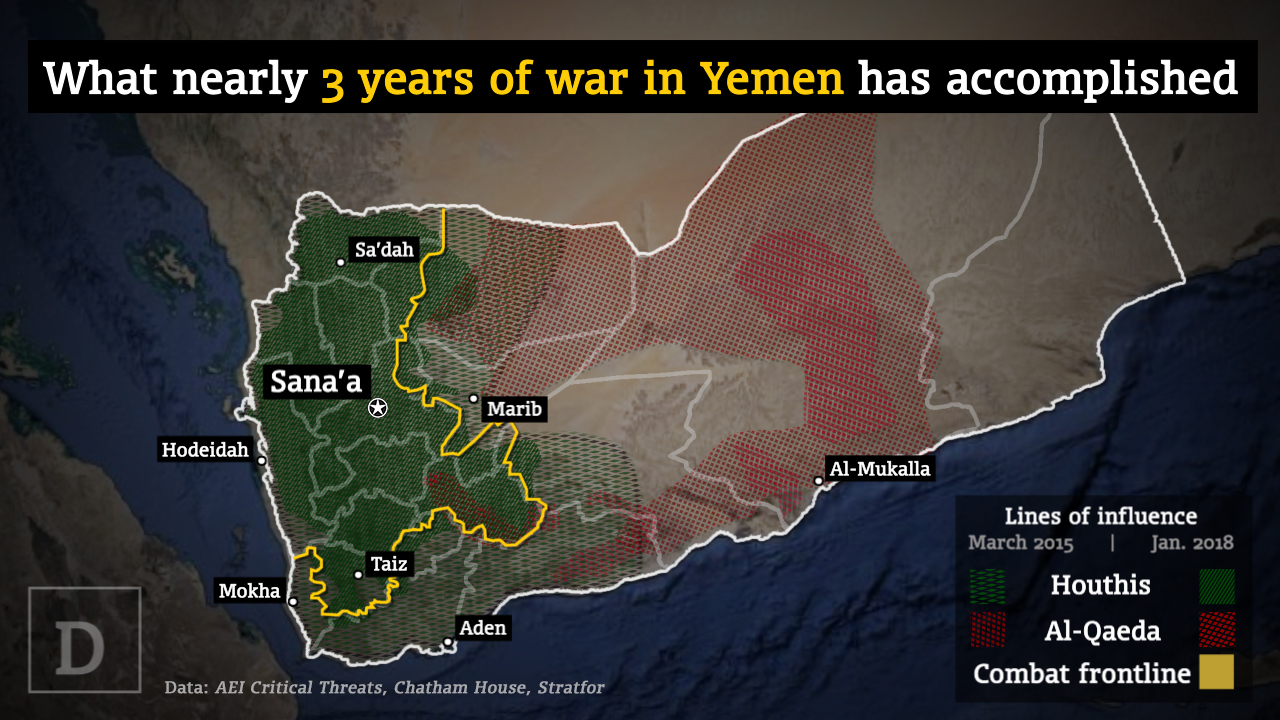
What lies ahead
The final weeks of 2017 were among the most fraught of the conflict for Yemenis. Former president Saleh, for months allied with the Houthis, offered to negotiate an end to fighting with Riyadh on Dec. 2, two days after the Saudis partially lifted their blockade. The Houthis interpreted Saleh’s announcement as changing sides, and 48 hours later, Saleh was found dead outside of Sana’a, reportedly from sniper fire. His death, and the quick sequence of events around it — including an alleged missile launch at an Emirati nuclear facility — have plunged Yemen into still further chaos and uncertainty.
Now more than 1,000 days in, Operation Renewal of Hope has yielded gradual advances along the southern coast, up to Taiz — near regions where tribes and loyalties can be dauntingly complex just in a single province. A small number of cities changed hands in the past year: Mokha in western Taiz, al Khawkha in western al Hudaydah, and Bayhan in northwestern Shabwah governorates, for example. But neither the Houthis nor the Saudi-led alliance appear to be close to victory.
Even as ISIS has attempted to move into Yemen carrying out sporadic, occasionally quite deadly guerilla-style attacks, little has changed about the dominant battle lines since at least April 2016. The advance on Mokha is a notable exception. Like the UAE’s alleged recent development on an island in the Mandeb Strait (view an animation of that here), staging out of Mokha will be key to the Saudis as they march slowly toward the capital in Sana’a and on — eventually, perhaps — to the birthplace of the Houthis in northern Sa’dah province.
But that, like Secretary Mattis’s goal of UN-brokered talks, still seems a long way off. “I think it gets worse, possibly a lot worse, before it gets better,” said Arterbury. “Both sides feel very emboldened right now. Both the Houthis, as I mentioned earlier, as well as the Arab coalition and the Hadi government, especially with their recent front-line successes, both groups feel empowered. There’s no incentive really to negotiate. The UN and the international mediation process seems to be just completely dead at the moment.”
Indeed, after nearly three years on the job, the UN's chief negotiator for Yemen, Ismail Ould Cheikh Ahmed, on Monday decided to step down from his post in February. (His convoy was attacked last May when he tried to visit Houthi-controlled Sana'a.)
“It’s easier to think about what we shouldn’t be doing,” said Kendall. “Like made it a stance of not selling arms to those who are dropping them on Yemen. That would help a great deal with international credibility. That’s perhaps not entirely realistic. Nevertheless it should be made. And it would help our long term credibility and therefore also our longterm security.”
U.S. arms manufacturers, for their part, have been very eager to help out, drawing up a $7 billion arms deal with Riyadh in November for precision-guided weapons and conversion kits to update older air-launched missiles. And the U.S. Congress has done little short of a symbolic, non-binding November vote in the House of Representatives authorizing U.S. pursuit of al-Qaeda and affiliated forces, but not against the Houthis. “In many cases, the Saudis have aligned with al-Qaeda to fight the Houthis undermining our very counterterrorism operations,” said Rep. Ro Khanna, D-Calif., the bill’s co-sponsor.
Three ideas for saving what's left
Few governance structures have endured Yemen’s latest war to emerge in a better position than before. From the Saudi coalition perspective, Marib province is one of them. In his December report, Chatham House’s Peter Salisbury described the country as having fractured into seven regions: “the Houthi-occupied north and west of Yemen; the highland tribal territories of Al Jawf, Mareb and Al Bayda; Taiz; the separatist tribal south; Aden; Hadramawt (coastal and northern); and Al Mahra.”
The result could be a new federalism for Yemen — a process Iona Craig admits failed in 2014, but seems to offer the best hope today “in order for people to really feel there is an end to this conflict at some stage in Yemen.”
“People want to know what the country’s gonna look like afterwards,” she said. “And I think at the very least, that’s gonna have to include federalism and some form of autonomy for both people in the South, and probably for the Houthis, who are still gonna have to be included in this process. I think it’s very hard to see the genie being put back in the bottle on that one.”
Salisbury offered a similar warning. “There is no easy way of transforming Yemen into a functioning, Westphalian model of statehood in the short time frame that many Western and foreign officials may wish for.”
Another problem is a general indifference toward the Yemeni government and those connected with it, said Kendall. “Nobody is that keen on — nobody outside the very top elites — is keen on having anything to do with any Yemeni government. Where it gets confusing is that people who are high-ranking in the regional leadership are also often involved in the smuggling trade, which has gone nuts over the last couple of years.”
This feeds into Yemen’s broader, chronic problems, said Kendall. In recent years, she’s turned more particularly to studying the appeal of al-Qaeda in Yemen. How is it, she asked, that AQAP held “influence over huge amounts of territory amongst populations that are well-armed, used to fighting, used to death — how could this happen?”
What she discovered: “It’s more of a negative thing,” she said. “It’s ‘Government’s doing nothing for us. International community has sponsored and helped to entrench our corrupt dictators.’” Or AQAP plays up the angle that when the international community does invest in Yemen, “it’s in development projects through organizations like the Department for International Development in the U.K., and possibly previously USAID, they have to do so through government structures, which makes them immediately in line with the corrupt regimes everybody hates and means that so much of the money is siphoned off.”
“Even when I listened to community leaders in Mukalla moaning about al-Qaeda and asking me whether there might be various ways of helping them to get rid of them,” Kendall said, “they at the same time said, ‘Well, you know they are approachable, and they are helping us with our water problem in my village. And finally, finally after decades I’m actually getting someone to listen to my land-snatch problem.’ And so there was a certain grudging respect.”
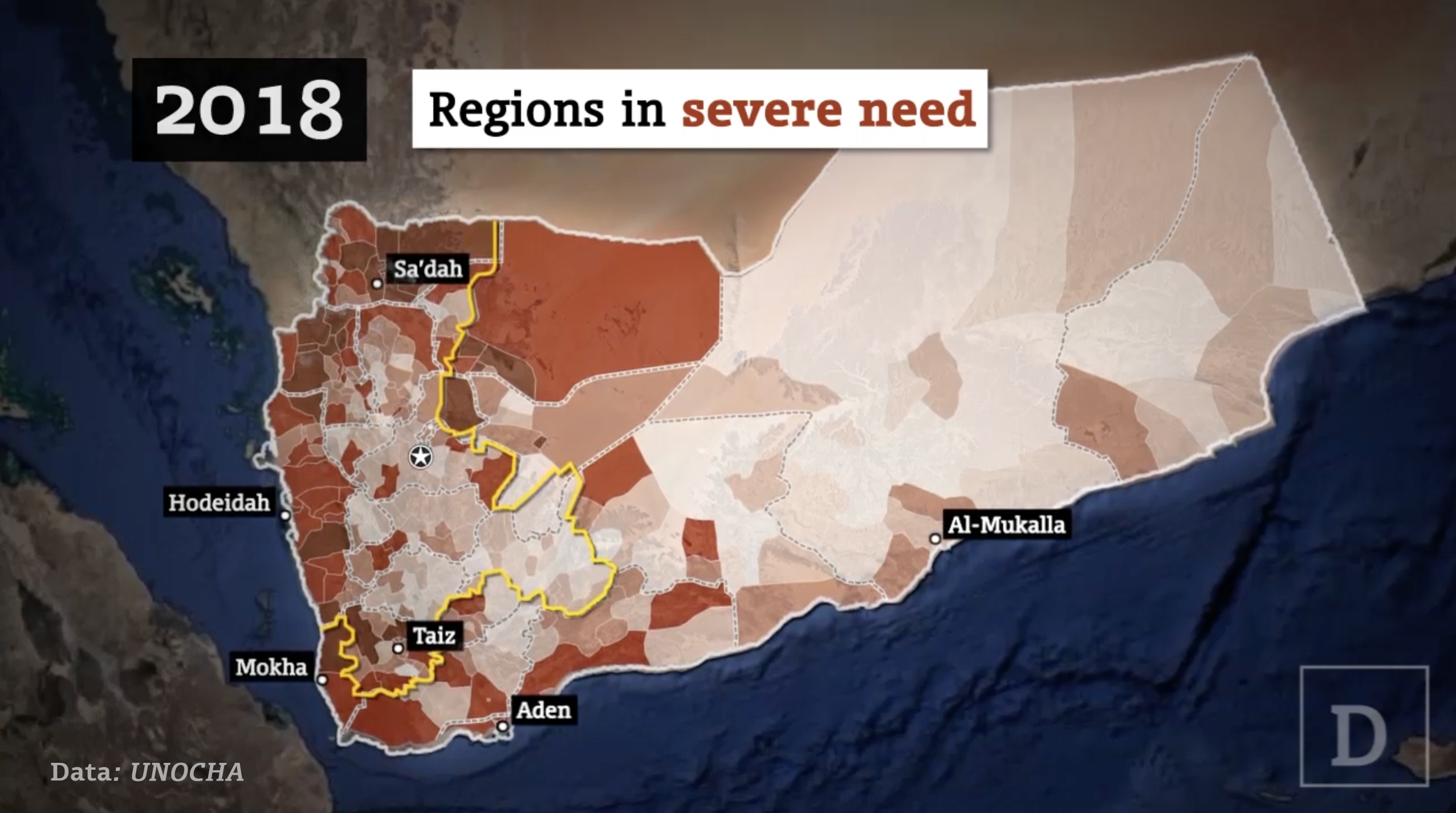
Some of the better solutions just might be small ones, Kendall said. “And that could be through a newspaper, or through radio stations. Giving people a voice” will go a long way in a country with such high levels of poverty and illiteracy. And this is a recommendation echoed by the Chatham House report. “Current policies and frameworks for peace in Yemen are built around simplistic, binary models of conflict that bear little resemblance to reality and that often reflect wishful thinking rather than careful analysis,” the report’s author wrote. “In particular, they need to lend as much weight to ground-up initiatives – complex, messy, difficult and time-consuming as these are – as to top-down processes.”
Whatever is done for Yemen’s future “needs to have a much, much better element of representation about it,” Kendall said. “And I’m not necessarily saying I think installing a full democracy in Yemen at the moment in the way that has perhaps been attempted in other other Middle East countries is necessarily the right way forward. But having people think and know that they’re represented is incredibly important. So one could have some kind of indirect democracy where you actually have local leaders whom you feel genuinely represent you rather than, ‘Oh, they’ve just been appointed by presidential decree by President Hadi sitting in Riyadh because they can help him achieve his war aims.’ Locals feel no buy-in at all with that. There’s got to be much better ways of getting people on side by thinking that they have a say in what’s going on.”
“If I had a magic stick, I would just get all these parties to the conflict settled and have a very strong peace solution with a very national-focused plan and force them to start to build the state again,” said Radhiyah Al-Mutawakkil. “I keep saying in Yemen, ‘There are no heroes. We have only criminals and victims.’ For me as a human rights defender, I want to take all those parties to the conflict to the garbage. But I know it’s only them who is going to stop the war. The humanitarian NGOs they are doing a very great job. But they are filling the gaps, only gaps. They can’t act as a state. For the Yemenis to move past this disaster, it needs a state.”
“The problem, as ever,” said Kendall, “is that we don’t know how [AQAP] might spring back to life again. It’s certainly had the life sucked out of it at the moment; not just by so many of its core mujahedeen being droned, but also deserters and fighters joining up with militias that are paying more perhaps, and who are just generally sick of being on the run when there’s so much heavy firepower being used against you.”
Those militias are often seen as the key to Yemen’s future. “Any place you go in to have an intervention, a CT [counterterrorism] intervention or a counterinsurgency intervention, you need buy-in from local partners,” Arterbury said.
The next problem, said Kendall, “is that when the UAE militias stop paying, when the heavy firepower goes away or recedes, it could easily come back again.”
To many Yemenis, “even if there is a military victory and Houthis was just kicked out of any governorate, they replaced these places with fanatic armed groups,” said Radhiyah. “So what do we do? We just pay all this prize just to replace a militia with another militia? And this is all happening in Yemen.”
At a minimum, of course, Yemenis really just need the basics, Craig said. “And that's food, water and electricity. I mean that’s when you go around Yemen and you speak to people, that’s what they want. Added luxuries are a judicial system, an education system that is functioning.”
If past is prologue, security won’t come to Yemen for a long time. And it may be even longer before even a fraction of repairs and infrastructure developments become a reality. After all, Craig said, food, water and electricity are “pretty basic needs and even before the war, a lot of Yemenis weren’t getting that.” 
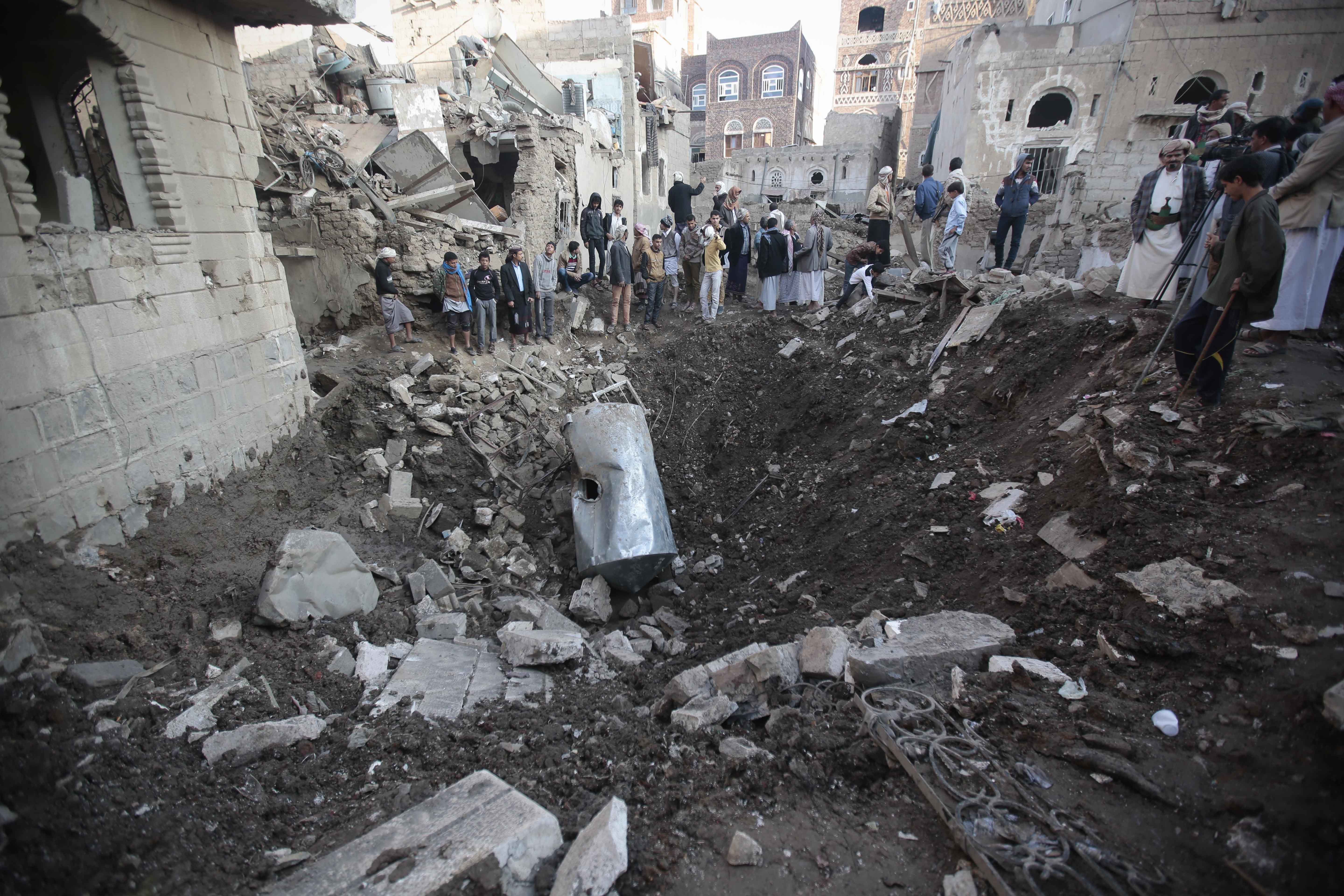
(AP Photo/Hani Mohammed)
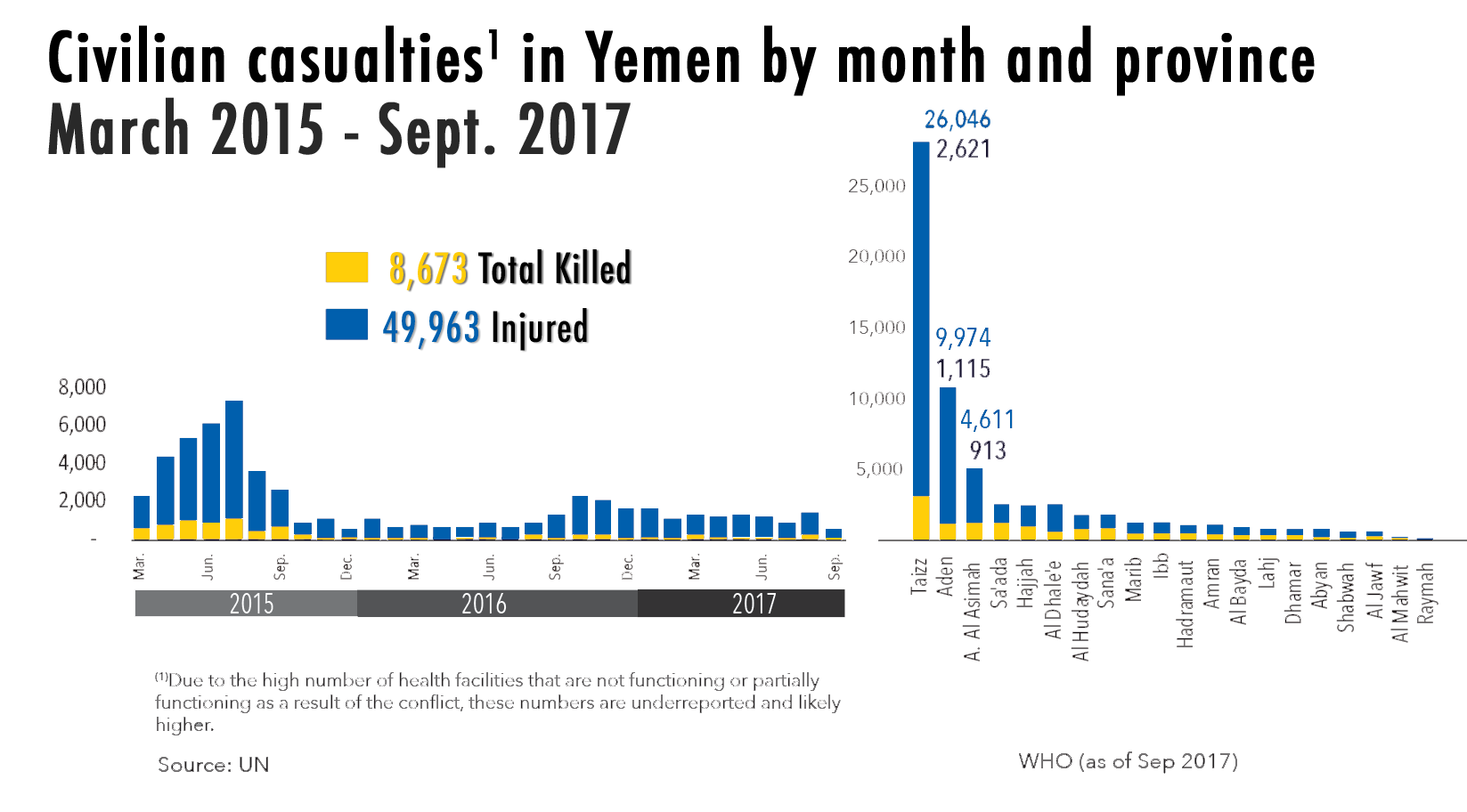
.jpg)